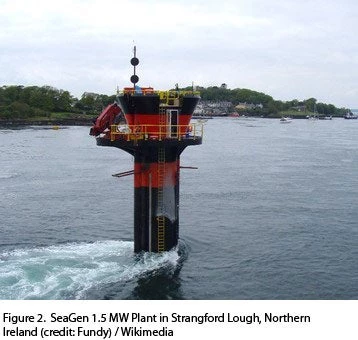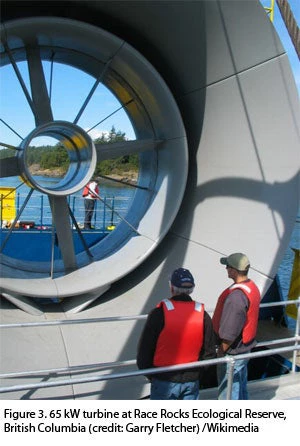 In-stream tidal units convert the energy of tides and currents into power – a type of hydropower which has operated successfully for decades. No matter what you call it -- wave, in-stream tidal, river current, or hydro turbines; or where it sits -- sitting on the river bottom or suspended from a barge -- the technology has proven itself. What has remained more elusive is the much-needed transition from subsidies to commercial financing.
In-stream tidal units convert the energy of tides and currents into power – a type of hydropower which has operated successfully for decades. No matter what you call it -- wave, in-stream tidal, river current, or hydro turbines; or where it sits -- sitting on the river bottom or suspended from a barge -- the technology has proven itself. What has remained more elusive is the much-needed transition from subsidies to commercial financing.
At the 5th Annual Small Hydro Conference in April 2013 in Vancouver, British Columba Chris Campbell of Marine Renewables, Canada, explained the two principal advantages of in-stream/tidal units:
1. Water has a high energy density -- the energy density from water is up to 50 times that of wind, and 100 times that of solar PV. For example, in a 2 knot current, each square meter of flow yields up to 500 watts of electricity. This means a wind turbine would require a 400 km per hour breeze to generate the same amount of power as the 1.5 MW Siemens generator in Strangford Lough (described below) does in in a 5 knot current; and
2. Predictability and reliability – the flow and timing of tidal streams are much more predictable and reliable than either wind or solar.
The original approach to using energy in the tides was to use tidal barrages (height difference = power), but now the emphasis is on tidal stream, where the energy is captured in ebb and flood currents as the tide changes. As shown in Figure 1, this means the most favorable sites are passes and headlands where tidal channels are created.
 This technology has proven itself. The River Rance scheme in France, inaugurated by President Charles de Gaulle, was connected to the grid in 1967. A Nova Scotia plant, on the Annapolis River, has recently been rehabilitated and updated after two decades of operation. The SeaGen plant, located in a narrow passage on the Stangford Lough in Northern Ireland (see Figure 2), has been in operation since July 2008: with very few problems it has pioneered the use of tidal currents.
This technology has proven itself. The River Rance scheme in France, inaugurated by President Charles de Gaulle, was connected to the grid in 1967. A Nova Scotia plant, on the Annapolis River, has recently been rehabilitated and updated after two decades of operation. The SeaGen plant, located in a narrow passage on the Stangford Lough in Northern Ireland (see Figure 2), has been in operation since July 2008: with very few problems it has pioneered the use of tidal currents.
Recently many new Canadian sites were identified, including:
- Nova Scotia (Bay of Fundy, anywhere from 300 to 2,500 MW potential);
- British Columbia (Vancouver Island – 62 sites, average 58MW potential; North Coast—18 sites, average 20 MW potential; or Haida Gwaii—9 sites average 9 MW potential), and
- The arctic has even more!
The challenge has therefore passed from proving the concept to moving the financing into the private sector and the reduction or elimination of subsidies. The first generation of plants had substantial subsidies. For example, the SeaGen plant cost GBP10.4 million, half of which came from the Great Britain Department of Trade and Industry. The Race Rocks facility (see Figure 3) was built with a C$3.0 million grant from the EnCana Environmental Innovation Fund.
In Canada, as explained by Campbell, no direct subsidies are available for tidal or current generators. However, these plants are eligible for provincial “Standard Offer Rate” programs, guaranteeing the ability to sell into the grid at set prices with long-term contracts. These and similar guaranteed arrangements could help get more projects financed using private and commercial sources. Suppliers, such as Alstrom, EDF, Iberdrola, Lockheed Martin and Siemens, are hopeful and are gearing up for an increase in demand. More competition among the manufactures should lower capital costs, making commercial financing easier.

As it currently stands, local permitting is a challenge, given the novelty and the marine setting. However, the turbines generally run at low speeds of around 50 rpm with large spacing between the turbine blades (see Figure 3), so there is no threat to marine wildlife. The regulation regime for these operations is also evolving; lawmakers in Canada are working to standardize national policies and procedures.
Tidal, and indeed the wave energy as well, are potentially important green technologies that can supply large and reliable quantities of electricity. The technology is proven and the plant sizes are growing. And, let's not overlook that smaller versions of these tidal devices work in rivers – this could be an important opportunity, even far from the ocean. Now we just need to shift from subsidies to commercial financing to get a rapid expansion in the industry.


Join the Conversation